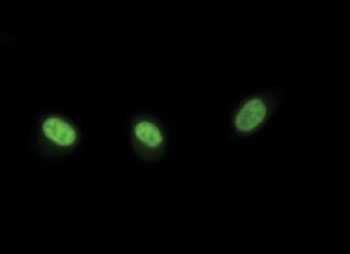Melanoma Development Depends on the Activity of the RUNX2 Transcription Factor
By LabMedica International staff writers
Posted on 28 Apr 2014
The transcription factor RUNX2 (runt-related transcription factor 2) has been found to play a critical role in melanomagenesis, the processes leading to development of the skin cancer, melanoma.Posted on 28 Apr 2014
The RUNX2 gene is a member of the RUNX family of transcription factors and encodes a nuclear protein with a Runt DNA-binding domain. This protein is essential for osteoblastic differentiation and skeletal morphogenesis and acts as a scaffold for nucleic acids and regulatory factors involved in skeletal gene expression.

Image: Expression of RUNX2 in the nucleus of 1205LU melanoma cells (Photo courtesy of the Rutgers Cancer Institute).
Investigators at the Rutgers Cancer Institute (New Brunswick, NJ, USA) examined the role of the RUNX2 transcription factor in melanomagenesis. They reported in the March 31, 2014, online edition of the journal Cancer Letters that the expression of transcriptionally active RUNX2 was increased in melanoma cell lines as compared with normal human melanocytes. Using a melanoma tissue microarray, they showed that RUNX2 levels were higher in melanoma cells as compared with nevic melanocytes.
Genetic silencing of RUNX2 in melanoma cell lines significantly decreased Focal Adhesion Kinase expression and inhibited cell growth, migration, and invasion ability. Furthermore, the pro-hormone cholecalciferol reduced RUNX2 transcriptional activity and decreased migration of melanoma cells, further suggesting a role of RUNX2 in melanoma cell migration.
“Successful efforts to render transcription factors “drugable” by interfering with different aspects of their transcriptional activity make this class of proteins attractive targets for therapy,” said senior author Dr. Karine Cohen-Solal, assistant professor of medicine at the Rutgers Cancer Institute. “Exploring the role of RUNX2 in the development of melanoma is likely to reveal new mechanisms driving melanoma progression and identify a target for novel antimelanoma agents, thereby opening new avenues for the treatment of this disease.”
Related Links:
Rutgers Cancer Institute










 (3) (1).png)


